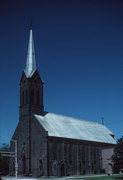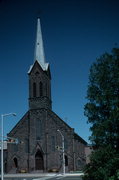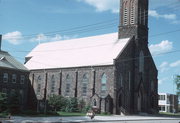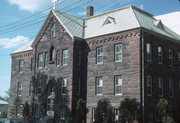Property Record
201 LAKE SHORE DR E
Architecture and History Inventory
| Historic Name: | ST. AGNES ROMAN CATHOLIC CHURCH |
|---|---|
| Other Name: | Our Lady of the Lake |
| Contributing: | |
| Reference Number: | 4349 |
| Location (Address): | 201 LAKE SHORE DR E |
|---|---|
| County: | Ashland |
| City: | Ashland |
| Township/Village: | |
| Unincorporated Community: | |
| Town: | |
| Range: | |
| Direction: | |
| Section: | |
| Quarter Section: | |
| Quarter/Quarter Section: |
| Year Built: | 1888 |
|---|---|
| Additions: | 1897 1901 |
| Survey Date: | 19752016 |
| Historic Use: | church |
| Architectural Style: | Early Gothic Revival |
| Structural System: | |
| Wall Material: | Brownstone |
| Architect: | J. S. Chevigny, architect Pernier and Chevigny, contractor |
| Other Buildings On Site: | |
| Demolished?: | No |
| Demolished Date: |
| National/State Register Listing Name: | Not listed |
|---|---|
| National Register Listing Date: | |
| State Register Listing Date: |
| Additional Information: | POINTED ARCHED WINDOWS AND DOORWAYS. OCULI IN STEEPLE AND IN ARCH OF MAIN DOORWAY. 2017 report information: Situated along both sides of the 200 block of Lake Shore Drive East, the former St. Agnes Church complex (now known as Our Lady of the Lake) consists of four buildings. They include the 1886-1901 Gothic Revival-style church (AHI#4349); a three-story rectory (1897; AHI#4328), a portion of the former De Padua High School building (1927-28; AHI#233754) and a two-story convent (1935; AHI#233755). Constructed entirely of Lake Superior brownstone, the church building is dominated by its central steeple, which was not completed until circa 1897. Pointed or Gothic-arch windows and doorways are found throughout the structure; sidewalls are delineated by stepped piers/buttressing that alternate with window openings. A corbel table delineates the upper edge structure on all four elevations. An anniversary history of the congregation cites that the structure was designed by “Brother Adrian,” a lay Franciscan brother who also reportedly designed the Holy Family Catholic Church (no longer extant). The interior wood carvings and altar is the work of brother artisans. The 1897 rectory is also constructed of brownstone and its primary (west) elevation features a central, gabled, projecting entry wing. The double-door entry is slightly recessed within a pointed-arch surround; a small arched niche is located along the second floor and the gabled peak features a window. Remaining fenestration is rectangular in shape and consists of replacement windows. The Mansard-style roof includes a variety of dormers and a denticulated corbel table lines the eave. In June of 1873, Dr. Edwin Ellis donated three lots of land for the establishment of a Catholic church. In 1874, construction began on the first frame structure but it was not completed until 1879. The congregation, however, did not formally incorporate until 1885. The following year, Ashland’s Catholic population had outgrown the frame facility and work commenced on a larger building that same year. By October 1887, the walls of the church were completed and a temporary tower erected. It took approximately ten years for the steeple to be completed and the side entrances were not added until 1901. In 1897, the rectory was built. As of 1928, high school classes were offered in the St. Agnes Academy building (1895; no longer extant) and the following year, De Padua High School opened in a substantial addition to the 1895 building. The high school continued through 1967, after which the 1895 portion of the building was demolished. In 1935, contractor Frank Tomlinson built the convent at an approximate cost of $15,000, from which a more recent two-story (and vinyl-sided) addition has been built. In 1958, a two-story, graded school classroom addition was completed east of the church. In 1990, Holy Family Catholic Church and St. Agnes merged, forming the current Our Lady of the Lake congregation. |
|---|---|
| Bibliographic References: | Eckert, Kathryn, The Sandstone Architecture of the Lake Superior Region. Detroit, Wayne State University Press, 2000. 2017 report citations for info in Additional Comments: Medard Buvala, History of St. Agnes Community, 1873-1973: Celebrating One Hundred Years of Faith (Ashland, WI: St. Agnes Community, 1973), 14, 19, 22-23, 38, 41. A photo of the church with its unfinished steeple is found in Harry H. Heming, The Catholic Church in Wisconsin (Milwaukee, WI: Catholic Historical Publishing Co., 1896), 774; Smith & Goc, eds., Looking Backward, Moving Forward: Ashland, The Garland City of the Inland Seas (Friendship, WI: New Past Press, Inc., 1987), 104-105; “Newspaper brief,” The Ashland Daily News, 29 October 1887; Sharon Manthei, Ashland: Oh How You’ve Changed, Vol. 2, Churches and Schools (Ashland, WI: Ashland Historical Society, 2004), 3, 34. |
| Wisconsin Architecture and History Inventory, State Historic Preservation Office, Wisconsin Historical Society, Madison, Wisconsin |





